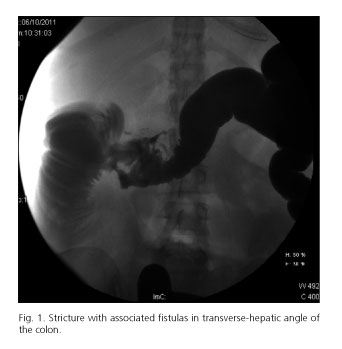Meu SciELO
Serviços Personalizados
Journal
Artigo
Indicadores
-
 Citado por SciELO
Citado por SciELO -
 Acessos
Acessos
Links relacionados
-
 Citado por Google
Citado por Google -
 Similares em
SciELO
Similares em
SciELO -
 Similares em Google
Similares em Google
Compartilhar
Revista Española de Enfermedades Digestivas
versão impressa ISSN 1130-0108
Rev. esp. enferm. dig. vol.106 no.5 Madrid Mai. 2014
LETTERS TO THE EDITOR
Severe colonic stricture related to acute pancreatitis
Obstrucción colónica secundaria a pancreatitis aguda
Key words: Intestinal obstruction. Acute pancreatitis.
Palabras clave: Obstrucción intestinal. Pancreatitis aguda.
Dear Editor,
Large bowel involvement in pancreatic disorders is uncommon with roughly 30 cases described in the literature, being even rarer acute pancreatitis associated colonic complications. We present herein a case of colonic stricture resulting in obstructive symptoms that complicated the course of acute pancreatitis.
Case report
A 43-year-old woman in the waiting surgical list for cholelithiasis and large hepatic adenoma (6.7 cm x 5.3 cm x 6.8 cm, in segment II-III) presented with severe abdominal pain, nausea and vomiting. Blood biochemistry was normal except for a marked rise in serum amylase at 3315 UI/L (normal, 25-115 UI/L). An abdominal ultrasound revealed cholelithiasis and dilated bile ducts, as well as an enlarged pancreas. A diagnosis of acute pancreatitis was then made. The subject did not meet any Ransom criteria. Initial outcome was complicated with acute renal failure and she was admitted to the intensive care unit. An abdominal CT scan was compatible with an acute pancreatitis Balthazar’s grade E. Late outcome was stormy as the subject developed Klebsiella pneumoniae sputum positive culture pneumonia with pleural effusion, urinary tract infection secondary to Candida albicans, and catheter sepsis with Staphylococci haemolyticus identified in blood cultures. In addition, she also developed thrombosis in catheterized internal jugular and right subclavial veins and severe protein malnutrition. Enteral nutrition was then tried but could not be kept because of recurrent vomiting and abdominal distention. A CT scan revealed complex fluid collections in right psoas as well as severe stricture in the right colonic angle with thickened folds and several fistulas then confirmed in a barium enema (Fig. 1). Because the subject was unresponsive to conservative management she underwent a surgical ileo-colical by-pass, cholecystectomy and resection of hepatic adenoma. At the time of this report, she is asymptomatic and abdominal CT scan reveals no abnormalities.
Discussion
Acute pancreatitis is an inflammatory process that eventually can affect others organs in vicinity (1). Colonic involvement in acute pancreatitis, however, is very uncommon not exceeding 1 % of the cases (2) regardless the etiology of the process (3,4). The most frequent sites of colonic involvement are the transverse, hepatic and splenic angle, probably due to anatomic proximity (3,4). Various pathogenic mechanism have been proposed: a) Direct spreading of pancreatic enzymes to the mesocolon through the retroperitoneal space; b) thrombosis or compression of mesenteric arteries leading to ischemic necrosis of the colon; and c) the combination of severe systemic hypotension leading to ischemia in the junction of median and left colonic artery as well as the hypercoagulability status typical of serious pancreatitis (2-4). Nevertheless, pathological findings including pericolitis and fat necrosis point toward direct enzymatic spreading (2). Clinically, colonic complications present like abdominal pain or mostly like sub-obstructive abdominal symptoms and the diagnosis is often difficult (3,4). The appropriate management of colonic involvement in acute pancreatitis requires the resection of the affected segment sometimes in association with a temporary colostomy. Nevertheless, in many instances a laparotomy is necessary to reach a diagnosis and to decide the best surgical alternative (2,3).
Aida Ortega-Alonso, Blanca Ferreiro-Argüelles, Manuel Jiménez-Moreno,
Josefa Calle-Calle and Raúl J. Andrade-Bellido
UGC Digestive Diseases. Instituto de Biomedicina de Málaga (IBIMA).
Hospital Universitario Virgen de la Victoria. Universidad de Málaga. CIBERehd. Málaga, Spain
References
1. Lujano-Nicolas LA, Perez-Hernandez JL, Duran-Perez EG, Serralde-Zuniga AE. Correlación entre criterios clínicos, bioquímicos y tomográficos para evaluar la gravedad de la pancreatitis aguda. Rev Esp Enferm Dig 2010;102:376-80. [ Links ]
2. Van Minnen LP, Besselink MG, Bosscha K, Van Leeuwen MS, Schipper ME, Gooszen HG. Colonic involvement in acute pancreatitis. A retrospective study of 16 patients. Dig Surg 2004;21(1):33-8; discussion 9-40. [ Links ]
3. Gardner A, Gardner G, Feller E. Severe colonic complications of pancreatic disease. J Clin Gastroenterol 2003;37:258-62. [ Links ]
4. Pascual M, Pera M, Martinez I, Miquel R, Grande L. Oclusión intestinal secundaria a pancreatitis que mimetiza una neoplasia estenosante del ángulo esplénico del colon. Gastroenterol Hepatol 2005;28:326-8. [ Links ]











 texto em
texto em 



